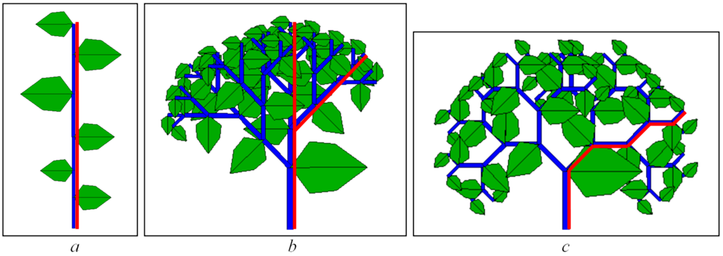GreenLab Course
Production-Expansion
Principles
-
Reminder. In the GreenLab model, phytomers of the same physiological age and the
same chronological age share the same fate
GreenLab Organ cohorts
-
Reminder.
-
Metamers of the same physiological age and the same chronological age are considered as identical,
whatever their positions in the plant structure.
-
The set defined by all metamers of the same physiological age p and the same chronological age t
defines organ cohorts Co(p,t), where o stands for the various organs borne
by the metamer.
Hence, in a given organ cohort, all organs are of the same type (leaf, internode, flower, etc.) and show the same properties and evolution.
The GreenLab models uses this assumption, evaluating biomass demand and biomass consumption from a single representative of each cohort, multiplied by the number of organs No(p,t) of each cohort Co(p,t).
Compared to process-based models, GreenLab can thus be seen as an extension, defining several cohorts for each organ type instead of a single compartment.
The set of cohorts reflects the establishment of minimized architectural dynamics, restricted to the physiological age and the organ age.
In practice, the cohort chronological age has to be expressed from two dates: the cohort appearance date da and the current date dc. The appearance date must be expressed relatively to the full plant appearance date, while the current date can be expressed relatively to the appearance of the set of organs (i.e. the cohort age).
Two cohorts Co(p,da, dc) and Co(p,da+i, dc+i) of the same organ, with the same number of organs, the same physiological age, the same age, but two different appearance dates show different evolutions, since the biomass availability level is not stable during plant development and growth.
Organic series
-
The evolutions of cohorts are called organic series, a term coined by R. Buis in 1983.
Ageing evolution
-
Ageing evolution of a given cohort Co(p,da,dc+n),
is simply the chronological evolution; the current date is incremented (by a number n of growing cycles). .
In such a case, usually:
-
- the number of elements in the cohort is assumed to be constant
- the corresponding organ sizes (corresponding to the biomass allocated so far) increase
- the corresponding organ gets older, and may reach its term of functioning.
Position along an axis
-
Evolution can also be considered on the basis of structural elements.
We will show further, that field observations of series built from organs on the same axis, from tip to insertion,
allow structural statistical properties to be expressed.
In this case, the series is built from representatives of cohorts on successive appearance dates, corresponding to successive ranks of organ insertion along the axis.
In fact, along the axis, the organic series can be considered from the list of successive cohorts related to the appearance dates dai -> daf (= dc) of the organs.
From top to bottom, each organ position defines a rank in the different cohort sets.
These ranks will be consecutive if the organ appearance was effective for each growth cycle (no rests).
Both organic series are independent from structure architectural considerations as shown below.

Organic Series in plant structures (Image P. de Reffye, CIRAD)
- These examples of series are shown in red, on three structures of the same
unique physiological age and the same chronological age.
a) A single axis with different phytomers. Two organic series respectively related to the leaves and the internodes describe the organ successions from upper tip to bottom.
b) A monopodial structure showing two similar organic series paths. From apex to seed, all organic series are identical; the successive organ ranks are related to the same cohorts.
c) A sympodial structure. Here also, from apex to seed, all organic series are identical. On this example, they are also identical to those of the monopodial structure, since cohorts from both monopodial and sympodial structures share the same number of organs and organ sizes.
Bibliography
Buis, R., Barthou, H. 1983. Relations Dimensionnelles dans une série organique en croissance chez une plante supérieure. IXème Congrès international de Biologie Mathématique, Paris, 8-10 septembre 1983. Bio-Mathematics revue, Les éditions européennes - France., pp. 1-19 (pdf)
